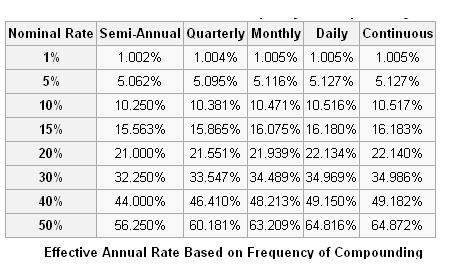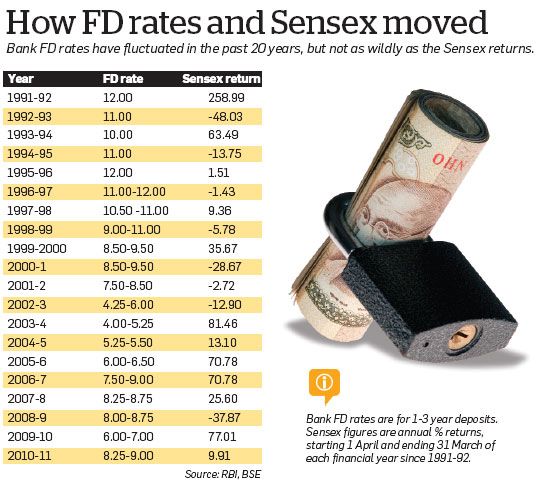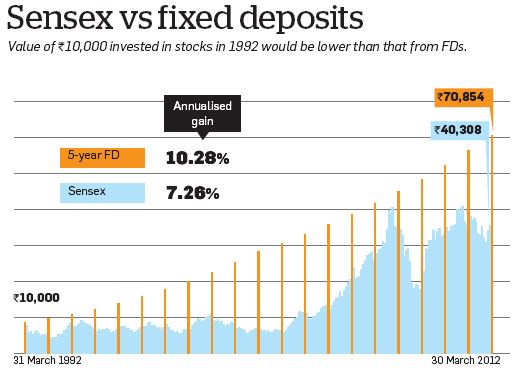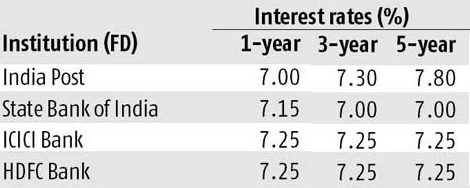In our article Overview of Fixed Deposit we had discussed about what is Fixed Deposit, interest rate, how safe it is, it’s liquidity – loan/premature withdrawal, tax, TDS, Nomination. This article goes in detail about Fixed Deposits and Interest Rates. How do interest rates affect maturity value? Comparison of Deposit Interest Rates Worldwide,Difference between Interest Rate and Annual Percentage Yield,FD rates in India from 1991-92,Why do Fixed Deposit Rates change?Comparison of Fixed Deposit with Sensex, Links to the banks Fixed Deposits.
Table of Contents
Interest Rate on Fixed Deposits
When you open a fixed deposit with bank then you are lending money to the bank and it pays you interest.
- Each bank or financial institution that is offering fixed deposits fixes its own deposit rates.
- Interest rates are subject to change from time to time.
- Interest of FD varies based on the time period, amount which is deposited.
- Most of the banks offer higher interest rate to Senior Citizens.
Image below shows the FD interest rate across various banks and post office (as on Oct 2016)
The interest rates on Below Rupees One Crore Domestic Term Deposits by State Bank of India are given below. (Updated on Jan 2017)(All figures in % per annum)
| Tenors | Existing for Public w.e.f. 24.10.2016 | Revised For Public w.e.f. 17.11.2016 | Existing for Senior Citizens w.e.f. 24.10.2016 | Revised for Senior Citizens w.e.f. 17.11.2016 |
|---|---|---|---|---|
| 7 days to 45 days |
5.50
|
5.50
|
6.00
|
6.00
|
| 46 days to 179 days |
6.50
|
6.50
|
7.00
|
7.00
|
| 180 days to 210 days |
6.75
|
6.75
|
7.25
|
7.25
|
| 211 days to less than 1 year |
7.00
|
7.00
|
7.50
|
7.50
|
| 1 year to 455 days |
7.05
|
6.90
|
7.55
|
7.40
|
| 456 days to less than 2 years |
7.10
|
6.95
|
7.60
|
7.45
|
| 2 years to less than 3 years |
7.00
|
6.85
|
7.50
|
7.35
|
| 3 years to less than 5 years |
6.50
|
6.50
|
7.00
|
7.00
|
| 5 years and up to 10 years |
6.50
|
6.50
|
7.00
|
7.00
|
Applicable interest rates will be given as on the date of receipt of the funds by the bank and is fixed for the specified duration. During the course of the FD, even if the prevailing interest rates go up or down, you will be entitled to the rate of interest that was promised to you when you first made the deposit. Hence the name Fixed Deposit –fixed period, fixed return fixed interest rate.
Interest Rate and Compounding
Interest on Fixed Deposit can be paid in two ways:
- Interest can be paid on a monthly basis or on a quarterly basis called the Traditional scheme or
- Reinvestment scheme or Cumulative Fixed Deposits where the interest is compounded to the principal amount on a quarterly basis and the interest is reinvested into the fixed deposit. So, after every quarter the principal increases by an amount earned as the interest in the last quarter. The invested amount along with interest is available only at maturity
In India typically for fixed deposits bank offer following terms
- For those deposits with a tenure of below 6 months, interest is calculated at maturity as Simple Interest. The period of Fixed Deposit is calculated in number of days.
- Interest is calculated on a quarterly basis for deposits of 6 months and above
- Interest for re-investment is calculated every quarter, and the Principal is increased to include interest earned during the previous quarter.
Just don’t see the interest rate but see compounding also. Let’s see with an example
Bank A offers deposit at the rate of 8% compounded yearly, Bank B offers deposit at the same rate of 8% compounded half yearly Bank C 8% compounded quarterly. Which one would you choose and why?
On Principal of 1 lakh Maturity value for different compounding period is given below. Interest would be = Maturity value – Principal.
| Period of Holding | Bank A(compounded yearly) | Bank B(compounded half yearly) | Bank C(compounded quarterly) |
| 1 year | 108000.00 | 108160.00 | 108243.22 |
| 2 year | 116640.00 | 116985.86 | 117165.94 |
| 5 year | 146932.81 | 148024.43 | 148594.74 |
A rate which might seem higher upfront might have a lower return if it is not compounded as frequently. Our article First lesson in financial education:Compound Interest talks in detail about difference between simple, compound interest and compounding frequency. To calculate Maturity value based on different compounding frequency you can use Fixed Deposit Calculator.
Compare Deposit Interest Rates Worldwide
As per deposits.org Highest Deposit Rates by Country as on Oct 2016 are given in table below. It also lists interest rates of other countries. India is placed somewhere in middle offering around 6.8% .
|
Country
|
Inflation
|
GDP
|
Population
|
Interest Rate
|
Change
|
Currency
|
Last Updated
|
|---|---|---|---|---|---|---|---|
| Argentina | 27.6% | 15,854 | 42,669,500 | 21.90% | – | ARS | Sep 2016 |
| Ukraine | 49% | 6,665* | 42,977,367 | 21.00% | – | UAH | Sep 2016 |
| Uzbekistan | 11% | $3,762 | 30,492,800 | 20.00% | – | UZS | Sep 2016 |
| Mongolia | 8.3% | 4,744 | 2,982,861 | 15.10% | – | MNT | Oct 2016 |
| Azerbaijan | 2.4% | 9,552,500 | 15.00% | – | AZN | Sep 2016 | |
| Iran | 15.3% | 12,258*** | 77,895,300 | 15.00% | – | IRR | Oct 2016 |
| Uganda | 4.9% | 1,305 | 36,600,000 | 13.00% | – | UGX | Sep 2016 |
| Armenia | 6.2% | 5,392 | 3,009,800 | 11.00% | – | AMD | Sep 2016 |
| Kazakhstan | 5.8% | 14,391 | 17,353,700 | 10.5% | – | KZT | Aug 2016 |
| Myanmar | 8.9% | 1327 | 51,419,420 | 10.00% | – | MMK | Oct 2016 |
| Syria | 59.1% | 5,041 (2010) | 22,920,273 | 10% | – | SYP | Sep 2016 |
| Georgia | 4.1% | 6,145 | 4,490,500 | 9.50% | – | GEL | Sep 2016 |
| Turkey | 7.8% | 13,905 | 76,667,864 | 9.25% | – | TRY | Sep 2016 |
| Turkmenistan | 9% | 9,510 | 5,830,756 | 9.00% | – | TMT | Sep 2016 |
| Ghana | 8.8% | 3,081 | 27,043,093 | 8.90% | – | GHS | Sep 2016 |
| South Africa | 5% | 10,229 | 54,002,000 | 8.83% | – | ZAR | Aug 2016 |
| Colombia | 3.4% | 9,046 | 47,865,600 | 8.27% | – | COP | Sep 2016 |
| India | 6.8% | 3,275 | 1,262,530,000 | 8.00% | – | INR | Sep 2016 |
| Russia | 8.9% | 14,913 | 146,149,200 | 8.00% | – | RUB | Oct 2016 |
| Rwanda | 5.9% | 1,354 | 10,996,891 | 8.00% | – | RWF | Sep 2016 |
| Tanzania | 7.8% | 1,505 | 47,421,786 | 7.50% | – | TZS | Sep 2016 |
| Pakistan | 7.7% | 2,683 | 188,145,000 | 7.27% | – | PKR | Jun 2016 |
| Egypt | 13.3% | 6,114 | 87,500,200 | 7.25% | – | EGP | May 2016 |
| Cambodia | 3.2% | 2,216 | 15,184,116 | 7.00% | – | KHR | Sep 2016 |
| Vietnam | 18.9% | 2,942 | 89,708,900 | 7.00% | – | VND | Sep 2016 |
| Bhutan | 11% | 6,370 | 753,980 | 6.75% | – | BTN | Sep 2016 |
Annual Percentage Yield
To promote financial products banks and other firms often quote the Annual Percentage Yield (APY) also called Effective Annual Rate (EAR) in finance. Annual Percentage Yield is a normalized representation of interest rate, based on a compounding period of one year.
Quoting example from onemint:Don’t confuse yields with interest rates Suppose the invest product offers you 12.00% interest rate compounded quarterly for the 3 year maturity period. If you invest 5000 Rs for cumlative option i.e you don’t get any interest payments during 3 years. At the end of 3 years you will get 7,128.80 i.e on Rs 5000 you get interest of Rs. 2128.80 for 3 years or interest per year is 2128.80/3 = 709.43. Annual Percentage yield in such a case is (709.43/5000) * 100 or 14.19%.
The formula to calculate APY is based on interest rate and the number of times per year interest in compounded.
APY= (1 + r ÷ x)x – 1
where x = number of times interest is compounded and r = quoted interest rate.
The more often interest in compounded, the higher the APY becomes as the year advances. APY for different rates at different compounding is given below.

Effective Annual Rate Based on Frequency of Compounding
FD rates over period of time
In India Bank FD rates have fluctuated over the last 20 years. The interest rates in 1991-92 were 12% and decreased 4-5.25% in 2003 before increasing to 8.25% to 9% in 2010-11. Interest rates from 1991-92 are given below

FD rates Sensex rates since 1991
Deregulation of Deposit Interest Rates in India: Earlier banks were allowed to set interest rates for maturities between 15 days and up to 1 year, subject to a ceiling of 8 per cent. As a result of price war among banks, the freedom to set interest rates subject to a ceiling was withdrawn in May 1985. The process of deregulation resumed in April 1992 when the existing maturity-wise prescriptions were replaced by a single ceiling rate of 13 per cent for all deposits above 46 days. In October 1997, deposit rates were fully deregulated by removing the linkage to the Bank Rate. Consequently, the Reserve Bank gave the freedom to commercial banks to fix their own interest rates on domestic term deposits of various maturities with the prior approval of their respective Board of Directors/Asset Liability Management Committee (ALCO). Banks were permitted to determine their own penal interest rates for premature withdrawal of domestic term deposits and the restriction on banks that they must offer the same rate on deposits of the same maturity irrespective of the size of deposits was removed in respect of deposits of 15 lakh and above in April 1998. Now banks have complete freedom in fixing their domestic deposit rates. Ref:RBI
Why do Fixed Deposit Rates change?
One of the main factors that influences the rate at which a bank sets interest is the actions taken by a country’s central bank. In India, the prevailing rate of interest is influenced heavily by Reserve Bank of India(RBI), which loans large sums of money to banks and other financial institutions. RBI increases its key policy rates when there is greater volume of money in the economy. In other words, when too much money is chasing the same or lesser quantity of goods and services. Conversely, when there is a liquidity crunch or recession, RBI would lower its key policy rates to inject more money into the economic system. RBI does not directly fix the deposit or lending rates of banks but uses instruments like Cash reserve ratio (CRR),Statutory liquidity ratio (SLR), Repo and Reverse repo rates are some of these tools. For details on these interested readers can read EconomicTimes:ET in the classroom: RBI’s key policy rates(Jul 2010)
Comparison of Fixed Deposit with Sensex
Economictimes:Don’t buy and forget if you invest in stocks for the long term(Apr 2012) compared the returns in Fixed Deposits with BSE Sensex. Quoting from article:
- The BSE Sensex was quoting at 4,285 nearly 20 years ago. It’s now at 17,404, an annualised return of a paltry 7.26%, which is well below the current high inflation rate.
- If the same money had been invested in a 1-year fixed deposit with a commercial bank and rolled over every year, it would have grown to Rs 49,722.
- If investors could have opted for five-year FDs that offered higher rates. This corpus would have been bigger at Rs 70,854.

Sensex vs Fixed Deposit
SuchetaDalal:Fixed Deposits Beats Stocks? Financial writers need financial literacy first (Apr 2012) finds flaws in the argument of Sensex worse than Fixed Deposits. Our article Comparison of Fixed Deposits and Sensex Returns(Coming Soon) discusses it in detail.
Fixed Deposits Links
Links to the fixed deposits of various banks are given below.
| Allahabad Bank | Andhra Bank | Axis Bank | Bank of Baroda |
| Bank of India | Bank of Maharashtra | Canara Bank | Catholic Syrian Bank |
| Corporation Bank | Central Bank of India | City Union Bank | City Union Bank |
| Dena Bank | Dhanalakshmi Bank | Federal Bank | HDFC Bank |
| ICICI Bank | IDBI Bank | Indian Bank | Indus Ind Bank |
| Indian Overseas Bank | ING Vysya Bank | J&K Bank | Karnataka Bank |
| Karur Vysya Bank | Lakshmi Vilas Bank | Oriental Bank of Commerce | |
| Punjab National Bank | Punjab and Sind Bank | South Indian Bank | State Bank of Bikaner and Jaipur |
| State Bank of Hyderabad | State Bank of India | State Bank of Patiala | State Bank of Travancore |
| Syndicate Bank | Tamilnad Mercantile Bank Ltd | The Ratnakar Bank | UCO Bank |
| Union Bank of India | Vijaya Bank | ||
| Foreign Banks | |||
| Abu Dhabi Commercial Bank | Bank of Ceylon | Citi Bank | China Trust Commercial Bank |
| Deutsche Bank | HSBC Bank | Standard Chartered Bank | Scotia Bank |
| Royal Bank of Scotland |
To compare Fixed Deposits you can use rupeetimes.com:Compare FD Rates, ratekhoj.com:Compare And Get Best Fixed Deposit Interest Rates in India, paisawaisa.com,All BankingSolutions:COMPARISON OF FIXED DEPOSIT INTEREST RATES BY INDIAN BANKS,
Related articles:
Hope the article helped you in understanding the interest rates, how compounding affects the Maturity Value, how FD rates have changed over time, why do FD rates change?





For one thing, the rifles that are chambered for the 30-30 are low-cost when compared to various other rifles chambered for various other rounds.
Variable power riflescopes were not created until the late
1940s as well as it was numerous years prior to they were trustworthy products both in performance and
also long life. Military sniper rifles are identified into 2 groups:
rifles to attain intended hits at distant distances, and the Designated Marksman Rifles to provide precise fire assistance for line troops.
Today, site visitors could visit the structures, several
of which use genuine display screens with artefacts
such as 19th Century firearm rifles or family tools as well as various
other products in fact utilized by the Russians. All
3 rifles are outfitted with Rock River’s winter
trigger guard as well as the ERGO Hold. Currently, nearly every nation has sniper
rifles as well as militants and also terrorists are using these rifles.
These rifles enable soldiers to hit
Please advise me Rate of Interest on Fixed Deposit under Tax Saving Scheme for 5 years, in Bank of India and Oriental Bank of Commerce as on 25/09/2009.
Which is a good fixed deposit policy of a lakh in life insurance company
One lakh life insurance fix deposit will very good option
Thanks for the latest update of fixed deposits and interest rates here also you can find good info about term deposit and fixed deposit
Thanks for the latest update of fixed deposits
Thank you for sharing such great information. It is informative.
These same apartment cleaning services Los Angeles use 100% biodegradable and green products.
Finally, I think parents and grandparents need to
make it clear to students that keeping the apartment clean is
a personal health issue. Equipment should also be serviced on a weekly basis to make them more efficient.
These same apartment cleaning services Los Angeles use 100% biodegradable and green products.
Finally, I think parents and grandparents need to make it clear to students that keeping the apartment clean is
a personal health issue. These mops can be a bit pricey
initially, but over time will add up to hundreds of dollars in savings on floor products,
especially if you have many types of flooring.
Nice topic, I’ve learned alot
Your design is absolutely amazing, good job